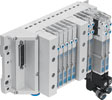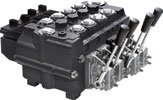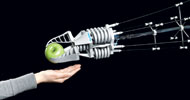

There is a common perception that not much is new in the world of pneumatics and hydraulics, but scrape the surface and a different picture emerges.
Dying technologies
Talk to most system integrators and control system engineers and they will authoritatively pronounce that pneumatic controls and devices belong in the ark. Their fellow mechanical and electrical engineers will explain that hydraulic actuators and motors are being superseded by their electrical counterparts.
But the statistics tell another story. Rob Carter, an analyst at IMS Research, blogged that the company’s latest studies show that the market for pneumatic actuators grew 8,2% from 2010 to 20111. Healthy growth trends have also recently been published by the UK’s BFPA, which noted that 16 countries reported double digit growth in hydraulic equipment sales from 2010 to 2011 and 20 countries reported positive growth in pneumatic equipment sales over the same period2. And in an August 2012 analyst briefing Frost & Sullivan predicted a compound annual growth rate (CAGR) of 5,6% through 2018 in the European Pneumatic Equipment Market3.
Drivers of change
It would be oversimplifying the situation to write that the causative factors driving change in these industries could be reduced to regulatory and green initiatives. Many of the discontinuities are highly interrelated and it is not easy to distinguish cause from effect. For instance, the development and adoption of new manufacturing methods like 3D-printing (aka additive layer manufacturing) for making both prototypes and production run components are driven in part by a desire to reduce machining and wastage – both of which are closely aligned to green motives. The creation of innovative materials like graphene is in part driven by the desire to make components smaller and lighter – goals that are intimately tied to energy efficiencies in both manufacturing and operational costs.
Fundamental drivers of change (causes) include:
* Safety, standards and compliance.
* Manufacturing efficiency.
* Operational efficiency.
Safety, standards and compliance
The last decade and the start of this decade have seen the introduction of a plethora of safety standards and regulations with which manufacturers and end users of pneumatic and hydraulic equipment are mandated to comply. Principal among those affecting users of these systems have been:
* The EU Machinery Directive4.
* ISO 10218 parts 1 and 2:2011 – Robots and robotic devices – Safety requirements for industrial robots5.
* ISO 23125:2010 – Machine tools – Safety – Turning machines Ibid.
* ISO 13849 part 1:2006 – Safety of machinery – Safety-related parts of control systems Ibid.
* ISO 16156:2004 – Machine-tools safety – Safety requirements for the design and construction of work holding chucks Ibid.
* ISO 13851:2002 – Safety of machinery – Two-hand control devices – Functional aspects and design principles Ibid.
* IEC/EN 61511 – Functional safety – Safety instrumented systems for the process industry sector6.
* IEC/EN 62061 – Safety of machinery: Functional safety of electrical, electronic and programmable electronic control systems Ibid.
* IEC/EN 61508 – Functional safety of electrical/electronic/programmable electronic safety-related systems Ibid.
Manufacturing efficiency
To remain competitive in a global village experiencing a Great Recession successful manufacturers have explored and adopted technologies with which to combat rapidly escalating input costs. Energy costs, rising raw material costs and labour costs have all been targeted. At the same time manufacturers have been forced to respond to regulatory and social pressures to reduce emissions.
Operational efficiency
Similar demands have been faced by operators (end users) who have also needed to reduce operational input costs and total cost of ownership (TCO). This has resulted in a need for equipment with longer operating lives, lower consumption of lubricants and fluids and requiring less maintenance.
Consequences
The consequences (effects) of responding to these drivers of change include:
* Component integration.
* Simpler system integration.
* Miniaturisation.
* New manufacturing methods.
* Innovative raw materials.
Component integration
Manufacturers in the fluid power arena have been making equipment smarter by integrating more components into functional units. In some cases this has been by incorporating more of the same technology and in some cases it has been achieved by creating hybrid devices combining pneumatic (or hydraulic) components with electronic components. According to Carter1, one of the reasons that have prevented a decline in the use of pneumatic equipment is the integration of electronics with air power.
Component integration can provide benefits such as cost savings and add intelligence to offer local loop control autonomy, self-diagnostics and ease of integration into digital control systems.
An example of same technology integration can be found in Parker’s integrated economy circuit for hydraulic circuits. Where previously such an energy recovery circuit was accomplished through external valves it is now achieved inside the standard valve housing.
Programmable position controllers which integrate electronics with pneumatics or hydraulics are examples of hybridised component integration. The Insight Air Cylinder from Motion Controls LLC is an excellent example of this, comprising a fully programmable pneumatic cylinder with integral keypad and QVLA LED light based position/volume sensing.
System integration
System integrators and machine builders can have their choice of almost any RS-232, RS-485 or Ethernet interface and protocol to interface their fluid control components to digital control systems for basic process control and for safety circuits.
For example Festo’s MPA-L valve terminal (Figure 1) can be equipped with network interfaces to most common industrial and Ethernet protocols via Festo’s CPX distributed I/O family. Even single hydraulic servo valves like Moog’s D670 series are available equipped with CANopen, Profibus or EtherCAT interfaces.

Miniaturisation
There is a prevailing trend towards miniaturisation. Smaller is better since smaller is lighter and generally costs less in terms of input costs (raw materials, handling, labour, conversion energy...), but the degree of feasible miniaturisation varies from application to application. For motive applications using fluid power there is some limit to how far manufacturers can progress along the miniaturisation route before cooling and flow rate issues come into play. In other applications like liquid and gas sampling, nanotechnology systems are being implemented that fall within the nanometre range – that is one billionth of a metre.
For off-highway vehicles the greatest motivator for miniaturisation has been the phased introduction of emission regulations by the US Environmental Protection Agency (EPA) aimed at dramatically reducing emissions of carbon and oxides of nitrogen. In 2014 Tier 4 Final will be introduced mandating near zero emissions levels. A similar initiative in the EU comes into effect in 2015. A direct consequence of these regulations is the need to improve fuel efficiency, and that has driven hydraulic reservoir sizes and circuit capacities down to reduce vehicle size and weight. Manufacturers have responded with more component integration, smaller devices capable of handling higher flow rates and increased system pressure.
A good example is Sauer-Danfoss’s recently launched PVG 100 High-Flow valve option (Figure 2) which offers a 30% increase in flow capacity in a claimed 'smallest on the market' package.

At the microscopic level 'lab-on-a-chip' sampling systems, micro-fluidics and the building of new materials through molecular manipulation are all distant cousins of the industrial pneumatic and hydraulic systems with which readers are familiar.
New manufacturing methods
This is probably one of the most exciting changes that is starting to impact the fluid power industry. 3D-printing is already being used in a limited way in the production of components for this industry. 3D-printing involves the use of a carefully directed laser beam on a powdered raw material which is either plastic based or metal based. As the laser strikes the powder it melts and then solidifies. Multiple passes of the laser solidifies one layer on top of the previous – hence the name additive layer manufacturing (ALM) or additive manufacturing.
ALM vastly reduces the amount of raw material and subsequent machining required for a part. EADS, the parent company of Airbus, uses ALM for manufacturing certain titanium brackets and claims that it is able to produce parts that use 25% less raw material, use 25% less energy to produce and that are 50% lighter than their machined equivalents7.
Additive manufacturing allows the manufacture of finished parts with complex internal voids, so manufacturing something like a hydraulic control block is child’s play for ALM. Often no additional surface finishing stages are required and there are no restrictions to the number or internal voids or their shapes. This means that instead of traditional hydraulic pathways that are machined from a solid block of material and that are full of energy sucking right angle bends, hydraulic systems can be manufactured with smoothly radiused internal bends.
In a case study8 by leading British additive manufacturer 3D RTP a twin-clutch gear change hydraulic actuator was redesigned to reduce mass and improve flow paths. The study showed that weight savings of over 30% were achievable with flow rate improvements of between 1,5 and 2,5 times.
Festo has made significant investment in ALM production capacity and has successfully used this technology to manufacture the FinGrippers (Figure 3) used in its Bionic Handling Assistant achieving an 80% weight saving over conventional metal grippers.

A further significant benefit of ALM is that because components are printed one at a time, with the laser being driven from the equivalent of a CAD file, it is no more expensive to make each new part unique, for instance by embedding a serial number or an end-user’s name. This has led to some commentators describing ALM as opening the way to 'mass customisation'.
Innovative raw materials
In response to green initiatives like energy conservation, the need to reduce harmful effluents, safety legislation, longevity requirements, new manufacturing methods and the opportunities opened up through rapid developments in materials science many new materials are being used in manufacturing and several harmful materials are being phased out.
Manufacturers of hydraulic cylinders have been looking at alternatives to hard chroming of piston rods and piston ends. Parker has been comparing PTFE coatings, ceramic coatings and coatings of various nitrides in conjunction with new matching seal compounds. It has concluded that there is no ideal mix of surface treatment, seal material and hydraulic fluid and that material selection is application dependent.
Manufacturers of hydraulic fluids have introduced zinc-free products in response to concerns about toxicity. Recently Shell announced the introduction of its Tellus S3 M zinc-free hydraulic fluid.
Graphene-based materials, with their high strength and electrical conductivity have been reported to hold great promise for actuators working like human muscles and activated by the application of voltage, heat or light9.
New nano materials have been developed for pneumatic and hydraulic oil filtration. Donaldson’s Ultra-Web filters for example are made of electro-spun fibres 0,2 to 0,3 microns in diameter and are capable of capturing particles down to as small as 0,3 to 1 micron10.
Conclusion
The winds of change are surely creating exciting opportunities for growth and a sustainable future for pneumatic and hydraulic equipment and systems and all those who work with these.
References
1. IMS Research: Is Energy Efficiency Hurting the Pneumatics Market? Not a problem . . . Yet! http://tinyurl.com/c558mmf
2. BFPA: BFPA Statistics Newsletter June 2012; http://tinyurl.com/c3vy2lj
3. Frost & Sullivan: On-Demand Analyst Briefing: European Pneumatic Equipment Market – What lies ahead? http://tinyurl.com/8v4ovda
4. European Commission: Machinery Directive 2006/42/EC; http://tinyurl.com/9ltjd8m
5. ISO: International Organization for Standardization; http://www.iso.org
6. IEC: International Electrotechnical Commission; http://www.iec.ch/
7. EADS: 2010 Annual Report; http://tinyurl.com/8udxayr
8. 3D RTP: 3D RTP; http://tinyurl.com/8clxfhg
9. The Center for Nanoscale Science and Technology: The application of graphene based materials for actuators; http://tinyurl.com/8m4tnr8
10. Donaldson Filtration Solutions: Ultra-Web Filter Media. What is Ultra-Web? http://tinyurl.com/8tyxsz5
| Tel: | +27 11 548 9960 |
| Email: | [email protected] |
| www: | www.profiafrica.co.za |
| Articles: | More information and articles about PI SA (PROFIBUS & PROFINET SA) |
| Tel: | +27 11 543 5800 |
| Email: | [email protected] |
| www: | www.technews.co.za |
| Articles: | More information and articles about Technews Publishing (SA Instrumentation & Control) |

© Technews Publishing (Pty) Ltd | All Rights Reserved